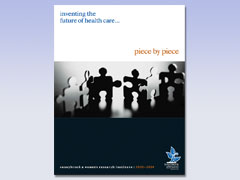A Sound Venture
Genetically altered mouse models of human disease are critical to understanding how diseases work and to creating and testing treatments for humans. But once you tinker with a mouse's genetic makeup, how do you know what effect the altered gene has had in that mouse? How can you tell if an experimental treatment is working?
As genomic research was erupting in the late 1990's, scientists were grappling with these problems, looking for efficient, noninvasive ways to track the progress of their experiments.
That's where Dr. Stuart Foster and his lab came in. Funding from the National Cancer Institute of Canada and the Canadian Institutes of Health Research allowed them to create a new ultrasound tool incorporating high-frequency transducers that made tiny physiological details – such as the blood flow feeding a mouse tumour – visible.
This creation sped up the process of scientific discovery. "Many more mice could be examined, many more drugs could be tested and more disease models could be researched," says Foster.
The demand for this new technology was so great that Foster, with support from the Ontario Research and Development Challenge Fund (ORDCF), formed VisualSonics Inc., a start-up that has grown to 58 employees over the last five years "The genome creates the questions," Tom Little, president and CEO of VisualSonics, Inc., says. "The animal models give us the answers. The things we're seeing continue to amaze me."
VisualSonics has since redeveloped the original prototype and sold 150 new systems to organizations like the National Institutes of Health, Harvard University and Stanford University, as well as most major pharmaceutical companies.
Creating this humane, non-invasive technology was "the tricky part," says Foster. But forming and funding a new company was not as easy as setting up a lemonade stand in your front yard. Commercialization through the investment of government and the private sector is an important way to expedite the development of new technology beyond that which academic funding can support. The process, Foster says with a raised eyebrow, was "very educational."
"Scanning mice as a commercial venture – that doesn't mean a lot to most venture capital people," says Foster. He notes that funding from ORDCF, in which industrial dollars are matched by the Ontario government and support from an institutional partner (SWRI was a willing participant in this case), was crucial.
Little agrees. "The ORDCF program allows us to invest in basic research that we otherwise could not afford to do." VisualSonics continues to grow and expects about $20 million in equipment sales in 2005. Any proceeds to SWRI, which is of course a non-profit organization, are rolled immediately back into research. Foster and his lab – which includes some 22 people Foster is quick to credit – are continuing to improve ultrasound techniques. And it is this – the drive to get helpful technology to the people who need it – that motivates him.
They are applying their ultrasound technology in studies using mouse models aimed at identifying and optimizing the selection of drug therapies in conditions like glaucoma, melanoma, and breast and prostate cancer. The next step is to use the technology in clinical trials. As Foster notes, it can take a long time for a drug to go from basic discovery to being approved for human use – up to 20 years for some. Thanks in part to Foster and his lab, the next generation of cancer therapy and ocular medications is likely to be in people's medicine cabinets much sooner.
PDF / View full media release »





